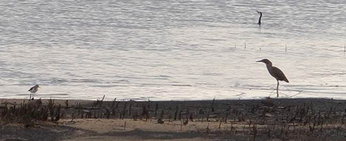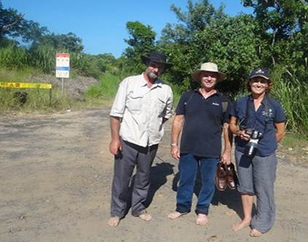
This week Ian Penberthy has gone to that great ‘recycle bin’ in the sky. Ian died in his beloved Innisfail of a heart attack on Wednesday. Ian’s life was a celebration of the natural world. He is best known for his Camel Tours, particularly with Sinai Guides, however his work with MATE, Man and the Environment, best explains Ian’s philosophy in life. Thank you Ian you were an example to all of us on how we can live a simple life and be content.
Cloud cover this afternoon brought a welcome relief to the oppressive heat. January without rain is certainly unusual and even more remarkable is the twinkling, turquoise Johnstone River and clear blue sky. The river at the mouth is thick with bait-fish and I found this small sting-ray swimming in the shallows off my beach, easy to see in the glass-clear water.

The cassowary scats are full of a wide range of seed and this week it includes a good percentage of pond apple seed. In spite of this Dad 1 and chick Rosie, Dad 4, Jessie, Big Sis, and the sub adults Don & Q are still all feeding from the feed stations.

On Thursday afternoon there was a meeting at Coquette Point to discuss the protection of shorebirds, particularly the Little Terns and the situation with dogs, particularly pig dogs and signage concerning these issues.

It was good to catch up with Bruce and we shared lots of memories from the 70’s when we were campaigning for World Heritage Listing of the Wet Tropics. Bruce was one of the many who stayed here for a short time many years ago. Bruce remembered Wendy, a road rescued paddymelon which hated men. Wendy would run out of the bush and attack any man she saw. I didn’t train her to do it, honest!
Anthony and Margaret’s house was checked out by the Cassowary family of Dad 2 and his chicks. Unfortunately Anthony and Margaret have built their house on what was a crossing-corridor for the cassowaries. However, there is another vacant bloke, close by on the ridge and the cassowaries will still be able to walk from the river in the north across the range and down to the mangrove forest on the ocean front. Cassowaries can be seen making this journey every day. A number of studies have noted that cassowaries need a mosaic of rainforest types and seem to prefer rainforest, melaleuca and mangrove forest mosaics. F. Chrome and A. Grahame (quoting from memory ].
Cheers for now,
Yvonne C.




